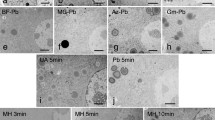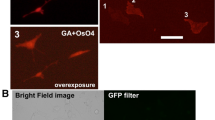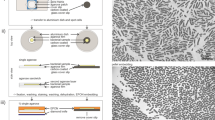Abstract
IT is a common practice to use buffers for making up fixing solutions for study of biological materials by electron microscopy, and such buffered fixatives are considered advantageous. This belief seems to have resulted from researches in days when the development of preparative techniques was in its infancy; and embedding media, like epoxy resins and polyester resins, were unknown in electron microscopy. It was experienced1 that fixation by simple distilled water solutions of osmium tetroxide followed by embedding in monomer methacrylates caused gross vacuolization of the ground cytoplasm, which resulted in disorganization of the cellular membranous system; the nucleoplasm also precipitated into a coarse reticulum. Further experiments suggested that these defects in preservation were caused by a wave of acidity produced by the reaction of osmium tetroxide with tissues; this acidity preceded fixation of tissues by osmium tetroxide. It was, however, discovered by Palade1 that preservation of cell structures was greatly improved if the fixative were buffered (pH. 7.3–7.5); and he recommended the use of Michaelis's2 sodium acetate/ sodium veronal buffer for this purpose. This buffer seems to have been more often used than any other for making up solutions of osmium tetroxide. It has also been adopted for buffering potassium permanganate3 and formaldehyde for use in electron microscopy, though formaldehyde reacts with veronal to produce a substance that has no buffering value in the range of pH. of physiological importance (7.2–7.5)4.
This is a preview of subscription content, access via your institution
Access options
Subscribe to this journal
Receive 51 print issues and online access
$199.00 per year
only $3.90 per issue
Buy this article
- Purchase on Springer Link
- Instant access to full article PDF
Prices may be subject to local taxes which are calculated during checkout
Similar content being viewed by others
References
Palade, G. E., J. Exp. Med., 95, 285 (1952).
Michaelis, L., Biochem. Z., 234, 139 (1931).
Luft, J. H., J. Biophys. Biochem. Cytol., 2, 799 (1956).
Holt, S. J., and Hicks, R. M., Nature, 191, 832 (1961).
Michaelis, L., J. Biol. Chem., 87, 33 (1930).
Baker, J. R., Cytological Technique (Methuen, London, 1960).
Malhotra, S. K., Quart. J. Micro. Sci. (in the press).
Malhotra, S. K., Quart. J. Micro. Sci., 103, 287 (1962).
Malhotra, S. K., Quart. J. Micro. Sci., 103, 5 (1962).
Malhotra, S. K., Quart. J. Micro. Sci., 104, 117 (1963).
Nichols, D., Quart. J. Micro. Sci., 100, 539 (1959).
Luft, J. H., J. Biophys. Biochem. Cytol., 9, 409 (1961).
Author information
Authors and Affiliations
Rights and permissions
About this article
Cite this article
MALHOTRA, S. Fixation for Electron Microscopy. Nature 198, 611–612 (1963). https://doi.org/10.1038/198611a0
Issue Date:
DOI: https://doi.org/10.1038/198611a0
Comments
By submitting a comment you agree to abide by our Terms and Community Guidelines. If you find something abusive or that does not comply with our terms or guidelines please flag it as inappropriate.



